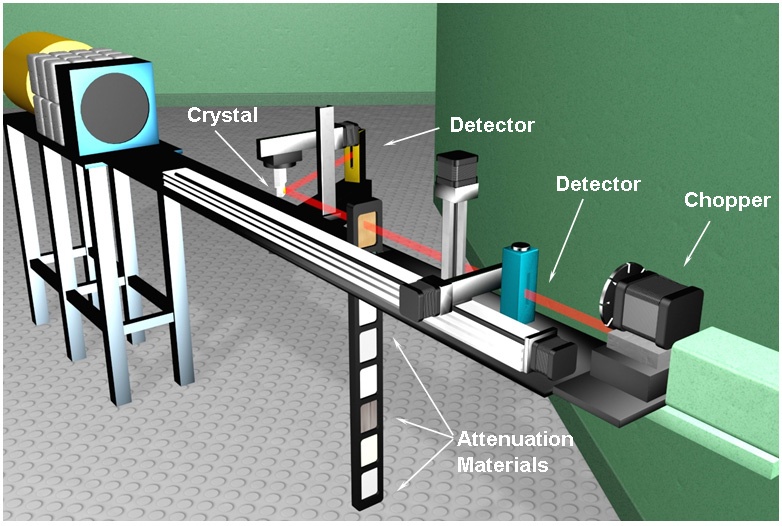The MIT Nuclear Reactor Laboratory
Three experiments:
- Neutron Beam
Demonstration of Half Thickness or Shielding Effectiveness in a Neutron Beam. The objective of this experiment is to demonstrate thermal neutron behavior in the presence of various absorption materials. The experiment utilizes a 4" beamport which provides a continuous beam of low-energy neutrons that is controlled using a mechanical chopper. Students are asked to calculate neutron flux and neutron density using the data gathered from the neutron detectors. Then, the students are asked to position standard pieces of lead, boron, cadmium, and aluminum prior to the neutron detectors in the beam guide tube. They perform another round of measurements. Based on the data collected, students are asked to calculate the half-thickness (or shielding effectiveness) of various materials.
- Maxwell Boltzmann Distribution
Measurement of the Maxwell Boltzmann Distribution of Thermal Neutrons from the MIT Research Reactor (MITR). The objective of this experiment is to correlate the temperature of the reactor with the availability of thermal neutrons for measurement, and then to compare the results with the Maxwell Boltzmann distribution that is predicted. The experiment utilizes a 4" beamport which provides a continuous beam of low-energy neutrons that is controlled using a mechanical chopper. Students are asked to perform measurements at two points in the beam guide tube using neutron detectors, multi-channel analyzers, and oscilloscopes. Students plot the data they gather and attempt to calculate thermal neutron velocity and flux density.
- Bragg Diffraction and the DeBroglie Wavelength
Demonstration of Bragg Diffraction and the DeBroglie Wavelength. The objective of this experiment is to demonstrate neutron diffraction using a crystal monochromater. The experiment utilizes a 4" beamport which provides a continuous beam of low-energy neutrons that is controlled using a mechanical chopper. Students are asked to measure the Bragg-diffracted beam that is created by altering the neutron beam path with a copper crystal. They perform several measurements at various angles of incidence, and are asked to plot their data to demonstrate the DeBroglie relation.
Website
Meeting Notes
Date |
Whom |
Description |
Link |
Nov 6, 2007 |
Kirky DeLong |
Meeting Notes |
|
Jan 15, 2008 |
Kirky DeLong |
Meeting Notes |
|
Feb 5, 2008 |
Kirky DeLong |
Meeting Notes |
|
Feb 21, 2008 |
Kirky DeLong |
Meeting Notes |
Documents and Materials
Description |
Link |
Reactor Experiment Write-up |
|
Introduction to Nuclear Power |
|
American Nuclear Society Meeting Presentation, July 2007 |
|
Images |
|
Time of Flight Experiment notes |
|
Remote Use Introductory Lesson Only notes |
Contacts
- Judy Maro (jmaro@mit.edu)
- Gordon Kohse (kohse@mit.edu)
- Yakov Ostrovsky (yakov@mit.edu)
- Raymond Ma (rayma@mit.edu)

9 Comments
Judith Maro
IP Address assignment:
Machine: SPEC-TEST.MIT.EDU
Address: 18.149.0.174
It should be in the DNS by noon tomorrow. Please confirm when you no longer need the address.
Raymond R Ma
"Final" version of VI has been finished and sent to everyone. This version has a shut-off procedure that automatically shuts off all components just as a double check to make sure that nothing remains running.
Only thing left is the materials experiment.
Raymond R Ma
IP Address assignment: 18.149.0.101
s-spectrometer.mit.edu
Remote desktop is functional, so system is ready to be put online
VI for the most part is operational and ready for all experiments
Yakov Ostrovsky
Uploaded some pictures of student spectrometer.
Yakov Ostrovsky
Here are two IP addresses for the network cameras:
Machine: SSC-1.MIT.EDU
Address: 18.149.0.180
Machine: SSC-2.MIT.EDU
Address: 18.149.0.179
Raymond R Ma
SSC-1 password and user name
User name: root
Password: zinkyboy
Raymond R Ma
Website Address: http://norbert.mit.edu/reactor/
Anonymous
impressive
Anonymous
you should never link a nuclear reactor and a computer
that's just an advice from a computer scientist ;o)
cheers,
seo
Add Comment